It’s Fowl Friday again, and almost three weeks since the new chicks arrived at Curbstone Valley, and much of the fluff has been replaced by feathers. This is especially true for the Delawares, Black Australorps, Buff Orpingtons, and Golden Laced Wyandottes. Do you remember being a teenager? Those awkward, lanky, pimply years?
The wing feathers are growing in very well though!
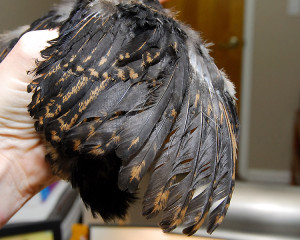
Not to be outdone, the Golden Laced Wyandottes are developing a lovely pattern on their wing feathers
Still a Mystery…
Mystery chick is still an enigma…and perhaps not what we first thought. We had guessed that maybe our ‘mystery chick’ was a silver-laced Cochin. Now, we’re not so sure.
Three weeks old and our mystery chick still has his/her racing stripes down the back, and a much higher amount of fluffage than anyone else in the brood. So, who are you?
With a little more rummaging around in the literature, there’s another possibility for our fuzzy enigma. A Dark Brahma. For more on the Dark Brahma (as this post will be a bit long with the rest of the week’s news), see this article by the American Livestock Breeds Conservancy.
Suffice it to say, the chicks of the silver-laced Cochin and Dark Brahmas initially have a similar color and pattern. However, we’ve noted that this chick is very slow to develop relative to the others.
The ashy down on the chest seems closer in coloration to the Dark Brahma chicks…but, we’ll have to wait and see who this chick turns out to be!
Whoa…Slow Down!
Of all the breeds, there is no question that the Delawares are developing the fastest. Sometimes rapid growth though can lead to trouble. On Tuesday morning we noticed that two Delaware chicks suddenly seemed to have crooked toes, and we were very concerned about the entire flock. We’ve never had this problem before. As they seem to change almost hour by hour, we knew we needed to act fast to identify and remedy any problems we may have with our flock.
Crooked toes in growing chicks is most commonly a manifestation of one of three problems.
1) Brooder Management
If the brooder is too cold, the chicks will pile up on top of each other to keep warm, which can lead to the chicks placing undue strain on their growing legs and feet.
Or, if the brooder is bedded with the wrong flooring material, like newspaper, which has a slick surface, the chicks constantly have to battle sliding across the floor, and this can cause orthopedic problems with crooked toes and/or splayed legs.
2) Nutritional Management
A nutritional deficiency, specifically in Riboflavin (vitamin B2), has been known for many years to lead to crooked toes in chicks. Any nutritional deficiency in an animal that grows as fast as a young chicken can manifest as a health problem, but Riboflavin has specifically been implicated in this condition.
3) Genetics
Crooked toes have also been shown, in some birds, to be genetic in origin. This may be a gene that is responsible for bone development, or perhaps a gene involved in regulating assimilation of nutrients (like Riboflavin) in the diet. Regardless, of all the causes of crooked toes, this is the one we have the least control over at the present. Although, breeders do have the responsibility of not knowingly breeding genetic stock that has a predisposition for disease, or developmental anomalies.
Fixing the Problem
So what caused the crooked toes in our Delawares, and how do we manage it? We don’t know the cause, and it’s not practical to try to definitively diagnose the problem, but we are taking steps to correct it.
Addressing Nutrition
We strongly doubt this is an issue with the feed. We feed a commercially regulated, pre prepared, balanced and organic feed. However, feed that has been stored for excessive periods, or faults in manufacturing can occasionally be issues, but are not common. Our feed is fresh, and we have an advantage in that we currently have 6 breeds of birds in the brooders (if you count our mystery fuzzy-footed chick). Examination of all of the other chicks showed that only two Delawares have the problem. Everyone else is just fine. We also noticed that the two affected Delawares, are the two in the flock that are largest, and growing the most rapidly.
The worst chick is the one we’d already dubbed ‘Godzilla’ (‘Zilla’ for short…it’s more feminine) as she has outpaced the other chicks significantly since the day she arrived, and always stands out in a crowd! Really, you can’t miss her!
For any animal that grows rapidly, even slight deficiencies in diet can manifest themselves easily. To address any potential common nutrient deficiencies in these chicks, we are now supplementing the entire flock with a water soluble vitamin supplement that includes Riboflavin.
Critically Evaluating Management
We also examined our brooder setup, which has worked fine for us in the past, but was anything different? There’s plenty of heat, as we’re using 250W infrared bulbs in the brooder boxes. We use cob-litter for bedding as it provides good traction, and is non-toxic. We also have variably sized perches (actually branches as they’re naturally roughened, not slick surfaced). So what’s different?
When we previously reared chicks, we had a very small number of birds, and used a different style of feeder, one that was difficult to perch on. With so many chicks this time we had little choice but to opt for a long trough style feeder to accommodate the chicks. At first it was a metal feeder, but a manufacturing defect caused one of the chicks to badly catch a toe on the first day, and so that feeder was removed and replaced with a feeder that had less sharp edges.
Could that be our problem? The feeder surface on the replacement plastic model is very slick.
A few birds, including Zilla, seem to enjoy trying to perch on the feeder. Although we raise the feeders every few days to keep the trough height at the level of the chick’s backs, they can practically fly now enabling them to perch anywhere they choose. Our only option seemed to be to either modify this feeder so they can’t perch on it, or change the style of feeder again. We opted to change it, even though Zilla’s problem could be a combination of factors, it doesn’t hurt to go back to what we know works.
The chicks are large enough now that it makes sense to split them into another brooder box. Our boxes are very large, but with as active as they are, more space to run around is never a bad thing. With less chicks in each brooder, we could go back to our original tall round feeders that can’t be perched on so easily.
Correcting Crooked Toes
Crooked toes aren’t necessarily permanent IF you can catch the problem soon enough. But how do you fix crooked toes? The chicks are growing so fast, their bones are growing so fast, that some improvement at least can be obtained by splinting the toes. However, splinting can also be dangerous if it’s not done properly. If you have a chick with crooked toes, please consult your Veterinarian!
At their rate of growth, you cannot simply splint a toe, and leave the splint on, because it will constrict the toes as they grow, restricting blood-flow, and cause many more problems than it is intended to correct. None of the chicks are intended to be marathon runners, and we caught the problem soon enough, that if this is as bad as it gets for Zilla, it’s really not that bad, and she’ll be able to get around just fine. However, if we can improve her toes, even a little, to prevent future foot problems, we want to try.
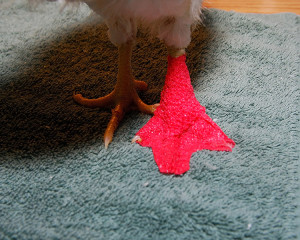
First the crooked toe was splinted, then Zilla was fitted with a new orthopedic shoe to help stabilize the toe
The first splinting earlier in the week did improve the toe position, but Zilla needed re-splinting this morning. This time, to prevent the toe from trying to curl over the splint, we’ve stabilized her toe with a nice new shoe …not exactly Manolo Blahnik, but pretty fancy, don’t you think? The goal here is just to keep the toe in the most natural position possible, but still enable her to perch. We’re splinting the toes for 48 hours, and leaving the splints off for 24 hours. Rinsing and repeating as necessary.
The chicks tolerate the splints just fine, and after the first minute or two they forget they have anything attached to their foot. Zilla doesn’t even seem to notice her new webbed ‘duck foot’.
The good news is that so far the problem seems stable. No new chicks are affected, and the two affected chicks don’t seem to be getting any worse. Over the next few weeks we’ll continue to evaluate the two affected Delawares, splinting toes and modifying shoes as needed. Next week we’ll see if Zilla’s toes have improved…Wish her luck!

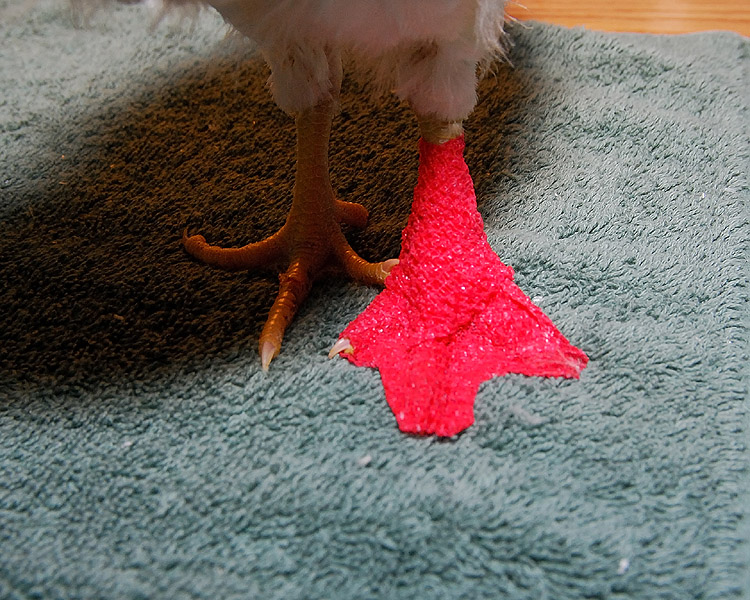
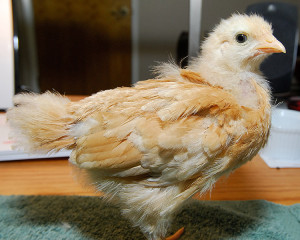
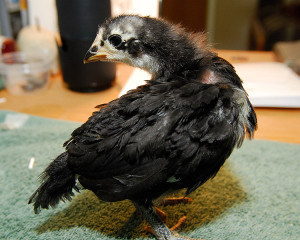
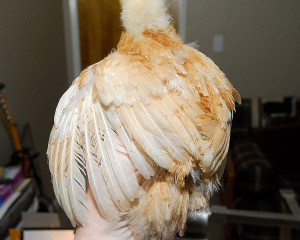
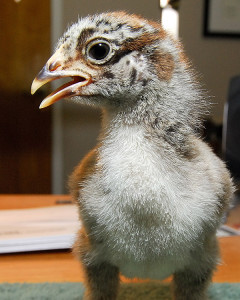
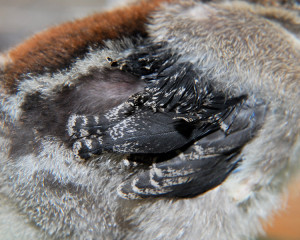
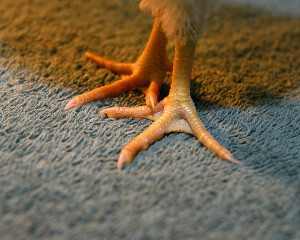
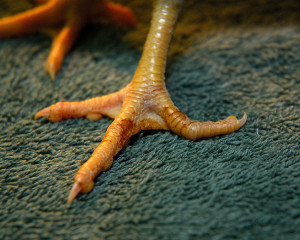
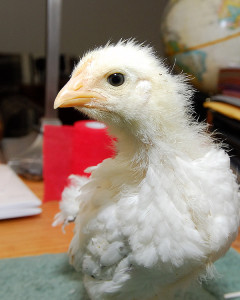
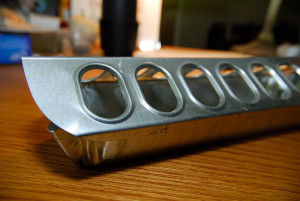
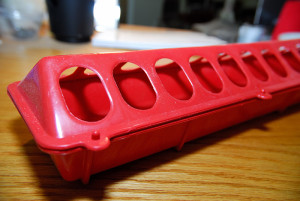

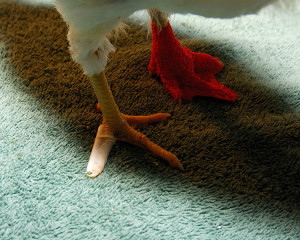







Our first three chickens we got as adults from a neighbor of a friend. They were all Barred Rocks, not related, but all raised from chicks by the same woman. None had ever been handled. They all have/had crooked feet. The one that had the worst feet ended up passing away just a few months after we took them. The other two are still laying eggs for us at 3 1/2 years old. They seem happy and they can roost fine. There’s nothing we can do about it at their age, but it doesn’t seem to affect them at all. I hope you can remedy the problem.
.-= Dog Island Farm´s last blog ..Friday’s Gardening Tips – How to Layout your Vegetable Garden- Part 1of 3 =-.
They’re growing fast!
They do grow fast! So much goes into raising chickens that I’m not even aware of. They are in good hands with you! That first photo is funny…they do go through an awkward stage. Looks like the feathers just don’t fit the body.
.-= Amy/GoAway, I’m Gardening!´s last blog .."Hold On, I’m Just Going to Take A Picture." ~ Amy =-.
Clare, I am very much enjoying your weekly updates on the chicks. It is amazing how quickly they develop, and I’m finding it all fascinating.
.-= Jean´s last blog ..Spring Blooms! GBBD, April 2010 =-.
awww the little chickie with the little red cast.
.-= Jess´s last blog ..Truly A Garden To Die For =-.
Oh goodness….
I had to smile at your last few photos. It is good that you have experience and check your chicks over carefully….it would probably be easy to miss the bent toe. I love the awkward stage photos 🙂
.-= Noelle/azplantlady´s last blog ..A Fool No More…. =-.
Dear Clare, How these chicks have grown in the space of such a short time and it has been so much fun watching them develop.
I was very concerned to read of the problem of the toes curling backwards and this posting informs most clearly about possible causes and solutions. I should never have imagined for one moment that this could occur.
But, what is so good, is that you have spotted the trouble and are correcting it. Would all farmers show this level of concern? I should like to think so but fear not.
.-= Edith Hope´s last blog ..White Linen, Magnolia and a Gherkin =-.
Talk about ugly ducklings!
Your splint reminds me of the booties that IBRRC puts on aquatic birds who spend the night inside, and are at risk of developing foot and leg sores. Your ‘Zilla must be very relaxed to allow you to apply her splint.
.-= lisa´s last blog ..Honeybee Swarm! =-.
Beautiful chicken, and the orthopedic shoe, it’s a very good job.
If I am lucky, at the end of April, I will have also chicken. Not for eat but for the eggs. But I must finish first, their home.
Bye bye.
.-= ellada´s last blog ..Haricot – – – Φασόλια =-.
Buff Orpington’s are such fabulous bird’s… I has one last year I called, Mama Chick. She would literally fly at me when I walked outside… just to be held.
.-= Dirty Girl Gardening´s last blog ..People Mag. Interview with the Dirtiest Celeb of Them All! (me, duh.) =-.
A great chapter indeed. On Thursday I said to myself “Oh goodie, …can’t wait, for tomorrow is Fowl Friday at Curbstone Valley..!” Hmm and what fowl knowledge will next Friday bring to your devoted readers…?
There’s certainly much to learn about chickens, I see! Good luck with your brood and I hope their tootsies straighten out nicely. 🙂
.-= Nancy Bond´s last blog ..So Much To Do, So Little Time =-.
I’m sorry to say I haven’t been following the chicks but today I had a chance to catch up. They really are cute now. We have a family near us, in the suburbs of Victoria, no less, who have some really beautiful chickens and I find on my walks I often end up there to visit them and admire them. I’ll be watching now to see how these little things transform into adults.
.-= Helen at summerhouse´s last blog ..Earth Day in the Garden from a Recycling Artist’s Perspective =-.
CSV, how are you? Glad to hear so much action is taking place with the chicks. I love the teenagers…so cute still with the baby faces but starting to show signs of maturity. I’m intrigued by zilla’s toe and the attention you are giving it. Is this chick a pet or produce? I give you much credit in taking care of her so well, not that any creature shouldn’t have such care. But it amazes me that you’d go to the trouble and care of splinting if zilla is not a long term member of your clan. Please let me know. I agree with the vitamins and fast growth…she outgrew her vitamin intake. She does look so sweet!
.-= Kimberly´s last blog ..Garden Bloggers Bloom Day April 2010 =-.
Kimberly, we rear our ladies for eggs…that’s the only ‘produce’ we expect. We enjoy having them around the farm, and even after egg-production drops off, they’re still valuable as bug catchers, weed-eaters, fertilizer-producers, and of course, they have lots of entertainment value too. They’re really pets. Certainly, many farmers would find them useless once peak egg production falls, and not bother to fix wobbly toes, but our ladies are in it for the long-haul…and unlike most of us these days, they actually have a guaranteed retirement plan 😛
Good luck, Zilla! That red shoe is the height of chick fashion. 🙂
It’s amazing how quickly they change. The cutie baby chicks are almost — almost — gone now. I’m kind of hoping the mystery chick is a Brahma after reading about them.
.-= Meredith´s last blog ..wordless wednesday =-.
They sure are growing fast. It seems like it’s been fun trying to figure out who that mystery chick is 🙂
This was so interesting, I had no idea about the problems with crooked toes and what the causes could be. That is quite the stylish orthopedic shoe Zilla has!
.-= Catherine´s last blog ..Fertilizer Friday the day after Bloom day. =-.
Hi, I read this post with great interest. It is very informative. As someone who is considering keeping chickens your blog is proving an invaluable source of information. And is keeping me down to earth and realistic about chicken keeping rather than getting carried away with a romantic idea.Thank you.
‘Zilla’ and ‘Frodo’…I can’t wait to hear the names you come up with for the rest of the flock Clare! I’m looking forward to showing these latest photos to my daughter – she pointed out the ‘awkward teenager’ chicken in the mini farm shed at her school to me the other day!
.-= Heidi (GippyGardener)´s last blog ..Gippy Garden Project List 2010 =-.
What darling little chicks! How lucky they are to have you as adopted mom!! Those little red shoes/splints to correct crooked toes are pretty fancy. Hopefully you will not be having dancing chicks after HCA’s fairy tale! I am so jealous… as I would love chickens. Good luck with the toe problems… hopefully this condition will not spread! I cannot wait to see who the little mystery guy is. This is another incredibly informative post … I always learn so much visiting your blog. Thank you!
.-= Carol´s last blog ..April Garden Bloggers Bloom Day and Blooming Friday! =-.
Clare I commend you for taking such dilligent care of your little chicks and writing such an interesting post as I knew so little about raising chicks until Fowl Friday started – I hope zilla’s crooked feet recover soon.
aren’t those little chicks well looked after.
You make me get over my chicken prejudiced. Nothing like having a neighbor with free ranging chickens (and roosters)to turn you off but these guys are too adorable.
.-= Karyl´s last blog ..Raising the Bat House =-.
I am learning a lot from reading about your chicken adventures. Learning so much, in fact, I am not tempted to try raising them myself (something my wife is no doubt glad to hear).
Your clan is really in good hands there at Curbstone Valley. How many chicks get their own orthopedic shoes?!?
.-= villager´s last blog ..Harvest Monday, April 19, 2010 =-.
I didn’t know orthopedic shoes were available for birds! How neat!
My goodness! I bet Zilla could swim in a neat little circle if set in a kiddie pond! Ridiculously adorable- Zilla and her ruby slipper, er… splint.
.-= Christine´s last blog ..Mariposa Lily: An Abrupt End to the Story =-.
It’s hard to imagine looking at them now that my buff’s were ever that size! Thank you for the info. on the toes, we rescued our Rhode Island when she was 8 months and almost all her toes were crooked (poor thing)so it’s so nice to know what caused this.